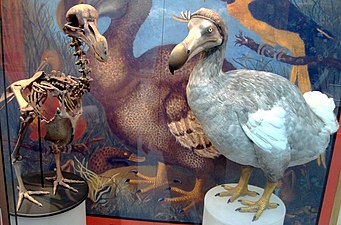Island syndrome

Island syndrome describes the differences in morphology, ecology, physiology and behaviour of insular species compared to their continental counterparts. These differences evolve due to the different ecological pressures affecting insular species, including a paucity of large predators and herbivores as well as a consistently mild climate.[2][3]
Ecological driving factors
- Reduced predation. Island ecosystems cannot support a sufficient biomass of prey in order to accommodate large predators. This largely relieves prey species of the risk of predation,[2] which mostly removes the selection pressure for morphologies, ecologies and behaviours that help to evade large predators.
- Reduced biodiversity. Insular ecosystems tend to comprise large populations of a limited number of species (a state termed density compensation), therefore, they exhibit low biodiversity. This results in reduced interspecific competition and increased intraspecific competition.[2]
- Reduced sexual selection. There is also reduced sexual selection in insular species, which is especially prominent in birds which lose their sexually dimorphic plumage used in sexual displays.[4]
- Reduced parasite diversity. Finally, there is reduced parasite diversity in insular ecosystems[5] which reduces the level of selection acting on immune-related genes.
Features of island syndrome in animals
Body size
Interspecific competition between continental species drives divergence of body size so that species may avoid high levels of competition by occupying distinct
Although the giant tortoises of the
Locomotion
Since insular prey species experience a reduced risk of predation, they often lose or reduce morphologies utilised in predator evasion. For example, the wings of
-
The southern cassowary, a flightless ratite native to Indonesia, New Guinea and northeastern Australia[1]
Adaptive coloration
Due to the reduced sexual selection of insular species, they tend to exhibit reduced sexual coloration so as to conserve the energy that this demands. Additionally, the low biodiversity of insular ecosystems makes species recognition less important so species-specific coloration is under less selection.[5] As a result, insular bird species often exhibit duller, sexually monomorphic plumage.[5]
Several insular species acquire increased
Reproduction
High levels of intraspecific competition between offspring selects for the very fittest individuals. As a result, insular parents tend to produce fewer offspring so that each offspring receives greater parental investment, maximising their fitness.[2] Lizards endemic to island ecosystems lay smaller clutches that give larger offspring compared to continental lizards of a similar size. Because of increased frequency of laying in insular lizards, continental and insular lizards produced offspring at a comparable rate.[14]
Brain size

The
Poikilothermy
Due to low predation risk, insular prey species can afford to reduce their basal metabolic rate by adopting poikilothermy without any significant increase in predation risk. As a result, poikilothermy is far more common in island species.[10]
Behaviour
Due to lack of predation, insular species tend to become more docile and less territorial than their continental counterparts (sometimes referred to as
In parasites
The nematode parasite Heligmosomoides polygyrus underwent niche expansion (by invading new host species) and a reduction in genetic diversity after invading ecosystems in seven western Mediterranean islands. The loss of genetic diversity was related to the distance between the contemporal population and the mainland origin.[20]
In plants
Plant structure
Plant stature and leaf area both follow the pattern of insular mammals, with small species becoming larger and large species becoming smaller in island populations.[2][6] This may be due to reduced interspecific competition which would decrease the ecological drive for plants to occupy separate niches. Due to reduced biomass of large herbivores, several island plants lose protective spines and thorns as well as decreasing the amounts of defensive chemicals produced. The improbability of island fires also results in a loss of fire-resistance in bark, fruits and cones. Insular woodiness, the evolutionary transition from herbaceousness toward woodiness, is a very common phenomenon among island floras.[21]
Reproduction and dispersal
Due to a lack of dedicated pollinators on remote islands, insular plants often use small, inconspicuously colored and easily accessible flowers to attract a range of alternative pollinator species. Self-pollination is also more commonly used by insular plant species, as pollen does not have to travel so far to reach a receptive ovule or stigma. Seeds exhibit
Consequences of island syndrome for conservation
The relaxed predation risk in
Hațeg Island
Reversed island syndrome
The term "reversed island syndrome" (RIS) was first used by Pasquale Raia in 2010 to describe the differences in morphology, ecology, physiology and behaviour observed in insular species when population density is either low or fluctuating.[27] This results in stronger natural selection and weaker intraspecific selection, leading to different phenotypes compared to the standard island syndrome.
RIS was first described in a population of
-
The insular subspecies of Italian wall lizard, Podarcis siculus klemmeri, exhibits darker blue coloration.
-
A mainland phenotype of Italian wall lizard with a lighter green-brown coloration
References
- ^ ISBN 978-0-8014-4501-9.
- ^ PMID 32315628.
- PMID 35440235.
- .
- ^ PMID 32315593.
- ^ PMID 31427521.
- .
- ISSN 1514-5158. Archived from the original(PDF) on 2011-07-06.
- ^ S2CID 83768608.
- ^ S2CID 86511951.
- S2CID 20356466.
- S2CID 231820197.
- .
- .
- PMID 21390261.
- PMID 19424156.
- S2CID 26441.
- S2CID 43166136.
- PMID 35440235.
- S2CID 83545722.
- ^ The evolution of insular woodiness - PNAS
- ISBN 978-1-4081-5725-1.
- ^ Benton, M.J., Csiki, Z., Grigorescu, D., Redelstorff, R., Sander, P.M., Stein, K., and Weishampel, D.B. (2010). "Dinosaurs and the island rule: The dwarfed dinosaurs from Hațeg Island. Archived 2011-07-10 at the Wayback Machine" Palaeogeography, Palaeoclimatology, Palaeoecology, 293(3-4): 438–454.
- PMID 28794222.
- PMID 20435913.
- .
- PMID 20854657.
- ^ .
- S2CID 52245927.




![Skeleton of the extinct moa from New Zealand alongside Richard Owen. Moa exhibited insular gigantism, small brain size[9] and complete loss of wings including the stylopod element.[9]](http://upload.wikimedia.org/wikipedia/commons/thumb/b/bb/Dinornis1387.jpg/181px-Dinornis1387.jpg)
![The southern cassowary, a flightless ratite native to Indonesia, New Guinea and northeastern Australia[1]](http://upload.wikimedia.org/wikipedia/commons/thumb/b/ba/Kasu%C3%A1r_p%C5%99ilbov%C3%BD.jpg/218px-Kasu%C3%A1r_p%C5%99ilbov%C3%BD.jpg)

